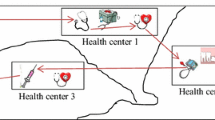Abstract
In this paper we present a deterministic allocation model in which a patient's health‐state changes due to health‐care interventions. This change in a patient's health‐state has a direct effect on the patient's expected future need for health‐care. Hence, current allocation decisions determine to some extent the set of possible allocation decisions in the future. In order to take this into account we have formulated a dynamic linear programming version of a patient‐flow system. This enables us to describe the effects of using different objective functions on the optimum level and composition of the provision of health services within given resource constraints. The linear programming approach enables the quantification of the health effects and therefore the desirability of the (re‐)allocation of health‐care resources. We provide some simulation results in order to illustrate the working of the model.
Similar content being viewed by others
References
Ministerie van Volksgezondheid, Welzijn en Sport, Jaaroverzicht zorg 1998 (SDU Uitgeverij, 's Gravenhage, 1998).
D.W. Light, The real ethics of rationing, British Medical Journal 315 (1997) 112–115.
J.M.H. Vissers, Patient Flow based Allocation of Hospital Resources (Technical University of Eindhoven, The Netherlands, 1994).
D. Boldy, A review of the application of mathematical programming to tactical and strategic health and social services, Operational Research Quarterly 27(2) (1976) 439–448.
A. Edgar et al., The Ethical Qaly: Ethical Issues in Health-care Resource Allocation (Euromed Communications, England, 1998).
A.A. Stinnett and A.D. Paltiel, Mathematical programming for the efficient allocation of health care resources, J. Health Economics 15 (1996) 641–653.
R. Gibbs, Health care resource allocation models, in: Operational Research Applied to Health Services, ed. D. Boldy (Croom Helm, London, 1981).
A.R. Taket, Resource allocation problems and health services for the elderly, World Health Statistics Quarterly 45 (1992) 89–94.
M.E. Cowen et al., A guide for planning community-oriented health care: the health sector resource allocation model, Medical Care 34(3) (1996) 264–279.
R.J. Gibbs, The use of a strategic planning model for health and personal services, J. Oper. Res. Soc. 29(9) (1978) 875–883.
D.J. Hughes and A.R. Taket, DRAM: a model of health care resource allocation, in: Health Projections in Europe: Methods and Applications (World Health Organization Regional Office for Europe, Copenhagen, 1986).
I. McKillop, The Patient Flow Model: A Resource-Based Approach to Optimizing Patient Flows (University of Waterloo, Ontario, Canada, 1997).
C. Murray and J. Kreuser, A Cost-Effectiveness Model for Allocating Health Sector Resources (Harvard School of Public Health, Mimeo, 1994).
A.M. Sheffet and P.V. Kakumanu, A multi-period resource planning model for a rehabilitation system, in: Proc. 3rd International Conference on System Science in Health Care, ed. W. van Eimeren et al. (Springer, Berlin, 1984).
P.J. Feldstein, Health Care Economics (Wiley, New York, 1983).
A. Berman and R.J. Plemmons, Nonnegative Matrices in the Mathematical Sciences (Academic Press, New York, 1979).
C.J. Murray, Quantifying the burden of disease: the technical basis for disability-adjusted life years, Bulletin World Health Organisation 72(3) (1994) 429–445.
R.T. Hoogenveen and S.E. Kooiker, Het inversieprobleem van stochastische matrices opgelost met behulp van de methode van de meeste aannemelijkheid, RIVM, Bilthoven, Report nr. 958606 003 (1990).
Author information
Authors and Affiliations
Rights and permissions
About this article
Cite this article
van Zon, A., Kommer, G. Patient flows and optimal health‐care resource allocation at the macro‐level: a dynamic linear programming approach. Health Care Management Science 2, 87–96 (1999). https://doi.org/10.1023/A:1019083627580
Issue Date:
DOI: https://doi.org/10.1023/A:1019083627580




